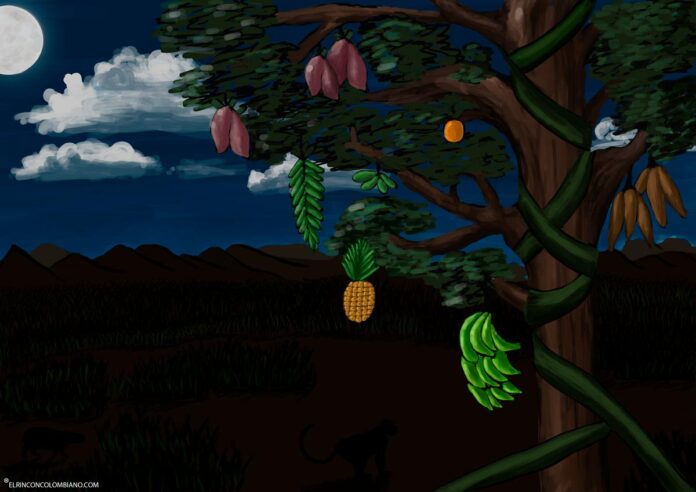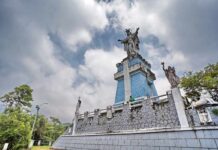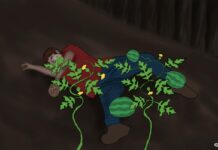The myth of Kaliawirinae either Kalivirnae The tree of life is a story that is part of the mythology of the guahibos either sikuani and tells the story of how fruits and foods were obtained and how they began to be cultivated.
It is said that at first there was no food, no one knew what cultivation was and the people, who at that time had the ability to transform into animals, had to eat roots, leaves or larvae, however, there was a member of the community who He always seemed happy and full, he was the Cuchicuchi (monkey), he spent all day sleeping and at night he escaped to no one knew where.
One day the members of the community approached him while he was sleeping and smelled a pleasant smell coming out of his mouth, then they began to wonder what Grandpa Cuchicuchi was eating that smelled so good. Tsamani The wise shaman of the community asked the picure to follow him when he ran away to find out what he ate, however the Cuchicuchi was cunning and managed to trick him by throwing branches, pieces of trees and fences that were not edible, he threw them at him and told him That was what he ate, so the shaman asked the limpet to follow him to see if he could discover it, the limpet was more cunning and did not let himself be fooled by the Cuchicuchi and after cunningly chasing him they reached the Orinoco River. , the monkey crossed it through vines and the limpet did so by swimming.
(Read Also: Myth of Bachué: The progenitor goddess of humanity (chibchas))
On the other side of the river the limpet found a huge tree in which the Cuchicuchi was eating fruits that it did not know. That tree had all kinds of fruits and foods, such as bananas, yams, yucca, pineapple, sweet potato, among many others. She saw on the ground the peels of the fruits that Cuchicuchi had eaten and the smells were very pleasant, then Cuchicuchi dropped a pineapple that he was eating, the limpet quickly took it and ran away, at that moment Cuchicuchi tried to grab it. to the limpet, but he only grabbed its tail and tore it off. It is said that at that time the limpet had a tail and that due to that event it lost it.
The limpet took the pineapple to where the Tsamani and the other members of the community were and they tasted the fruit and were happy with that food, then the limpet guided them to the Kaliawirinae tree, where they were finally able to eat those fruits and satisfy their hunger. .
The shaman, thinking of a way to have the fruits everywhere and for all the members of the community, thought that the best way would be to cut the tree and spread its fruits so that they would grow, but they would need tools to be able to cut down such a large tree. so they sipped yopo, to think of a solution, the wise Tsamani decided that they would go ask for help Palamekunü since he had tools that could serve them.
(Read Also: Myth of the Origin of the Sun and the Moon (Arhuacos))
After an arduous trip, Tsamani and several members of the community arrived at Palamekunü and negotiated with him for the tools. However, he did not want to collaborate easily, but Tsamani, knowing Palamekunü, already had a plan devised, he transformed into a mosquito and got into the Palamekunü's nose until it made him vomit the tools they needed. The members of the community took the tools and left to cut down the tree, but before leaving, Palamekunü's woman gave them 3 wrapped ones and warned them not to open them until they had reached the tree. their destination and finished the work, but curiosity won them along the way and they opened the envelopes, from the first came the thunder, the storm and the winds, from the second came the dark night and from the third came plagues.
After overcoming the difficulties that those involved brought them, they finally reached the tree and began to cut and cut until they split it in half. However, during the night the tree regenerated, making all the community's efforts useless. Tsamani asked then to the bachacos (ants) to collect all the splinters and pieces of the tree before it regenerated again and transport them far away so that it would not regenerate again. The bachacos did so and took these pieces far to the river. This is how the large stones were created. that are in the rivers that formed the Maipures rapids and Apures, but even the tree did not fall completely, because the vines barbasco and kapi The ones who tied him were tied to heaven and earth, so Tsamani asked the Jay que los picara hasta cortarlos, pero cuando este lo hizo la savia del árbol lastimo sus ojos, así que Tsamani le pidió a la ardilla que con sus dientes los cortara, la ardilla así lo hizo, después de roer los bejucos logro cortarlos, pero el bejuco que estaba atado al cielo la jalo con tanta fuerza mientras caía por completo el Kaliawirinae que envió a la ardilla hasta el atardecer, es por ello que para el pueblo sikuani cuando un atardecer es rojizo dicen que es el atardecer de la ardilla porque esta se estrelló contra el atardecer.
(Lea También: Iraca y Ramiriquí: Mito del origen de los humanos, el sol y la luna (Chibchas))
After that everyone took the seeds of the fruits and were able to plant them and start conuco (orchard or plot where it is grown), thanks to the work they undertook as a community to achieve that great undertaking of cutting down the tree, the Sikuani people learned what the unuma (the work, the team) and this is something that they still maintain today as an important value of the community.
From this fact also arise the different clans that make up the Sikuani community, which are named by the ancestral animals they could become, which are: tiger, macaw, picure, fish, toad, tapir, dog, snake, caiman and ocarro. .
After the fall of the Kalivirnae tree, the Sikuani say that time began to run towards the future because it fell downwards; if it had fallen upwards, everything would remain as it was in that eternal and immortal moment.
Other Versions of the Kaliawirinae myth
Because myths are oral traditions that are passed from generation to generation, there are several versions of them where different details are mentioned. In some versions of this myth it is mentioned that men did not transform into animals, but that they were originally animals and after the events that occurred with the Kaliawirinae they transformed into humans, in other versions it is said that before these events they were immortal. and because of what happened, death came into their lives.
(Read Also: Legend of the tuhuayo and the Moon (uitoto))
There are other versions in which it is told how during the trip several characters die due to not following the Tsanami's instructions. Other versions say that the origin of the tree occurs after a great storm that destroyed all the food, leaving only the Kaliawirinae tree.
This myth is also known as Kaliawirinae, the tree of life, because not only did all the food sprout from there, but also the clans, the conuco, teamwork and various customs that persist among the Sikuani community.
Many more versions of this myth can be found that depend on the community from which it is told, as well as the elements that are added or removed over time between the change of generations, the interpretations of these make of the same and the events they are suffering.
Origin of the Kaliawirinae Tree Myth
This myth has its origin in the indigenous culture of the Guahíbos, Sikuani, Jivo or Jiwi as they are also known, in this myth the Sikuani seek to give an explanation to origin of food, the Agriculture and also to other social elements such as teamwork.
(Lea También: Bochica: El mito del dios maestro civilizador de los muiscas)
This myth can be considered one of a series of myths that intertwine and make up the worldview of the Sikuani people, starting with the Kusubaüwa myth in which the Kaliawirinae tree is born from a young man who transforms into the tree and the myth of Tsamani as a third part where it is told how the family ascends to heaven after having danced and gone through various difficulties.
The Sikuani People live in Colombia in the departments of Goal, Vichada, Arauca, Casanare, Guainía y Guaviare; In Venezuela it lives in the states of Amazonas, Bolívar and south of Apure.
Did you like this article? Leave your opinion in the comments and share this story with your friends and acquaintances so they can discover our unique stories.





